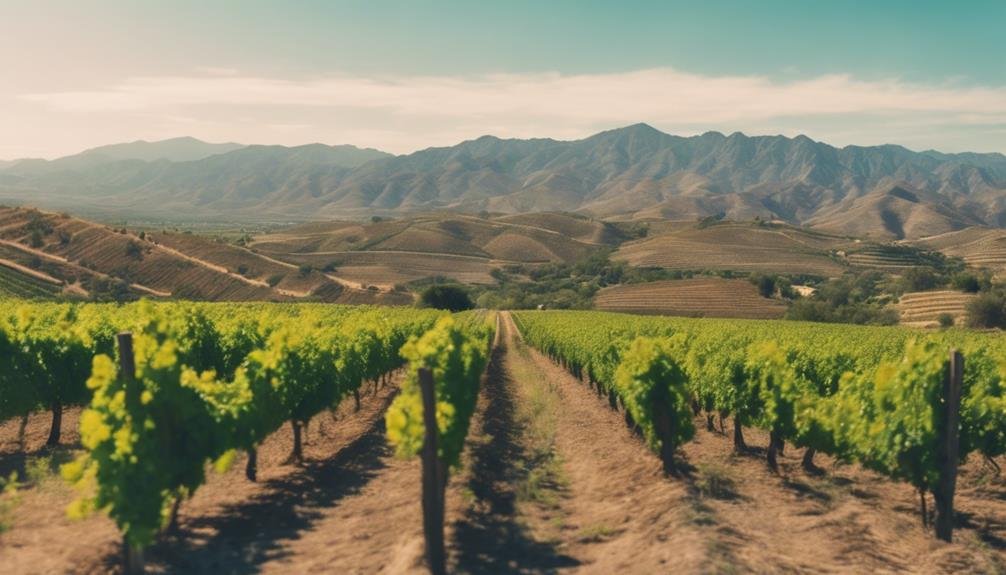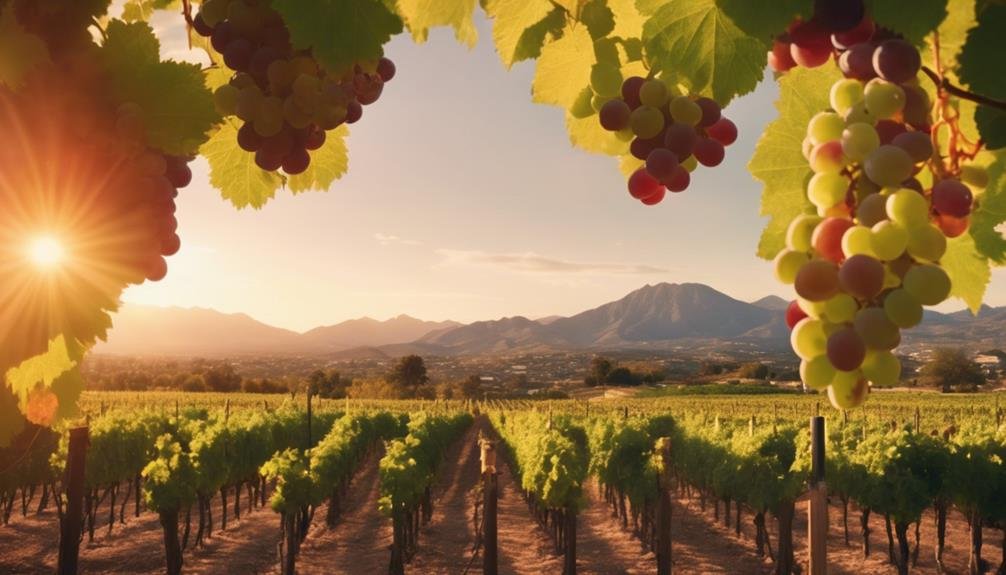Begin on a vibrant journey through Mexican wine, where history meets innovation. With 7,700 acres of vineyards cultivating diverse grape varieties, Mexico offers unique blends like Cabernet Sauvignon with Grenache. The bold Tempranillo, often aged in oak barrels, embodies Mexican terroir. Explore regions like Baja California and Valle de Guadalupe, where high-altitude vineyards create exquisite flavors. Engage in wine culture through tastings, vineyard tours, and the lively Fiesta de la Vendemia. Mexican wines are gaining global acclaim, with exports to 38 countries. Discover the enthralling world of Mexican wine and uncover a treasure trove of flavors and stories awaiting your exploration.
History of Mexican Wine
How did the rich history of Mexican wine pave the way for the modern Mexican wine industry as it stands today?
The Spanish influence from the 16th century played a pivotal role in initiating grape cultivation in Mexico. This historic foundation laid the groundwork for the development of the modern Mexican wine industry, which began flourishing in the 1970s.
Today, Mexico boasts 7,700 acres of vineyards, cultivating a diverse array of grapes including French, Spanish, and Italian varieties. The blending of grapes like Cabernet Sauvignon with Grenache and Barbera has been a popular choice, although single varietal wines are gaining traction.
This deep-rooted history intertwined with modern techniques has propelled Mexican wines to new heights.
Diversity in Mexican Wine Grapes
Diversifying the Mexican wine industry, a wide range of grape varietals, both red and white, contribute to the rich and robust flavors characteristic of Mexican wines.
- Tempranillo Characteristics:
- Known for its bold red fruit flavors and elegant tannins.
- Often aged in oak barrels to enhance complexity.
- Terroir Influence on Grape Varietals:
- Mexican terroir, with its diverse soils and climates, imparts unique characteristics to grapes.
- High-altitude vineyards contribute to acidity and freshness in white wines.
Mexican wines, including those made from Tempranillo, showcase the country's wine-growing potential influenced by its terroir.
Exploring Mexican Wine Regions

Mexico's diverse wine regions offer a unique tapestry of terroirs and grape varietals that contribute to the country's burgeoning wine industry. When exploring Mexican wine regions, one can witness the rich history and innovation of winemaking. From the North, with Baja California and Sonora, to Central Mexico regions like Zacatecas and Querétaro, each area showcases distinct characteristics that shape the wines produced. Terroir exploration reveals the influence of soil, climate, and altitude on the flavors and aromas of Mexican wines. Emerging winemakers are making their mark by experimenting with different grape varieties and winemaking techniques, adding a fresh perspective to the industry. The table below provides a brief overview of key Mexican wine regions:
| Region | Notable Features |
|---|---|
| Baja California | Over 150 wineries with Mediterranean climate |
| Valle de Guadalupe | Prominent for wine production |
| Sonora | Mainly produces grapes for brandy or raisin production |
| Valle de Parras | Known for wine grape growing |
| Central Mexico | Soils are loamy clay, suitable for wine grape cultivation |
Mexican Wine Culture and Tourism
Discovering the vibrant world of Mexican wine culture and tourism reveals a rich tapestry of traditions and experiences for enthusiasts and travelers alike.
- Wine Tasting: Engage your senses in the diverse flavors of Mexican wines through guided tastings at local vineyards.
- Vineyard Tours: Immerse yourself in the picturesque landscapes of Mexican wine country with guided tours of vineyards and winemaking facilities.
- Fiesta de la Vendemia: Experience the vibrant wine culture firsthand by attending the popular wine festival in Ensenada, held in August.
- Ruta del Vino: Explore over fifty wineries in the Baja region through the famous Ruta del Vino, offering a unique opportunity for wine enthusiasts to indulge in Mexican wine culture.
Global Presence of Mexican Wine

With an expanding international reach, Mexican wines are increasingly enchanting the global wine market with their unique flavors and distinct characteristics. Mexican wines have been gaining international acclaim for their full-bodied, ripe, and robust flavors, drawing attention from wine enthusiasts worldwide.
The market expansion of Mexican wines can be seen through exports to 38 countries, showcasing the growing demand and recognition for Mexican wine on a global scale. Regions like the Baja California and Valle de Guadalupe have become prominent for their wine production, with over 150 wineries in Baja alone.
Winery tourism is on the rise, with events like the Fiesta de la Vendemia in Ensenada attracting wine lovers from all over. Mexican wines are making a mark on the global stage, solidifying their presence in the wine industry.
Frequently Asked Questions
What Are the Traditional Winemaking Techniques Used in Mexico?
Traditional winemaking techniques in Mexico encompass a blend of Old World practices with modern innovations. From natural fermentation to aging in oak barrels, vineyard practices emphasize sustainable cultivation. Regional variations influence tasting notes and ideal food pairings.
How Has Climate Change Impacted Mexican Wine Production?
As climate change impacts Mexican wine production, vineyards are adopting sustainable practices to mitigate challenges. Alterations in rainfall patterns, temperature shifts, and increased pest pressures necessitate innovative approaches to uphold quality and guarantee longevity.
Are There Any Indigenous Grape Varieties Used in Mexican Wines?
Indigenous grape varieties play a vital role in Mexican wines, reflecting grape origins and terroir influences. These grape varieties, combined with modern techniques, result in unique and flavorful wines that showcase the diverse and rich heritage of Mexican winemaking.
What Is the Significance of Mexican Wine Labels and Classifications?
Mexican wine labels play a pivotal role in communicating taste profiles and quality to consumers. Label design and marketing strategies are essential in conveying the unique characteristics of each wine, influencing purchasing decisions and promoting brand recognition.
How Are Mexican Wines Adapting to International Wine Trends?
Mexican wines are adapting to international trends through sustainability practices and implementing innovative techniques in vineyards. Quality standards are being elevated to meet the demands of the global market, positioning Mexican wines competitively.
Conclusion
Just as a fine wine matures over time, the Mexican wine industry has evolved into a flavorful journey that captivates enthusiasts worldwide.
With a rich history, diverse grape varietals, distinct regional characteristics, and a growing global presence, Mexican wine continues to leave a lasting impression on the palates of those who appreciate its unique terroir and vibrant offerings.
Embrace the essence of Mexican wine and commence on a delightful journey of discovery and enjoyment.
